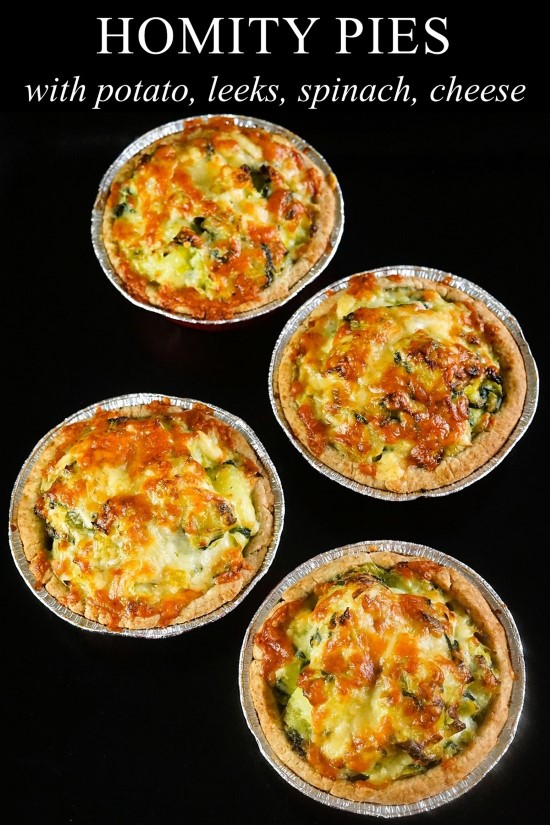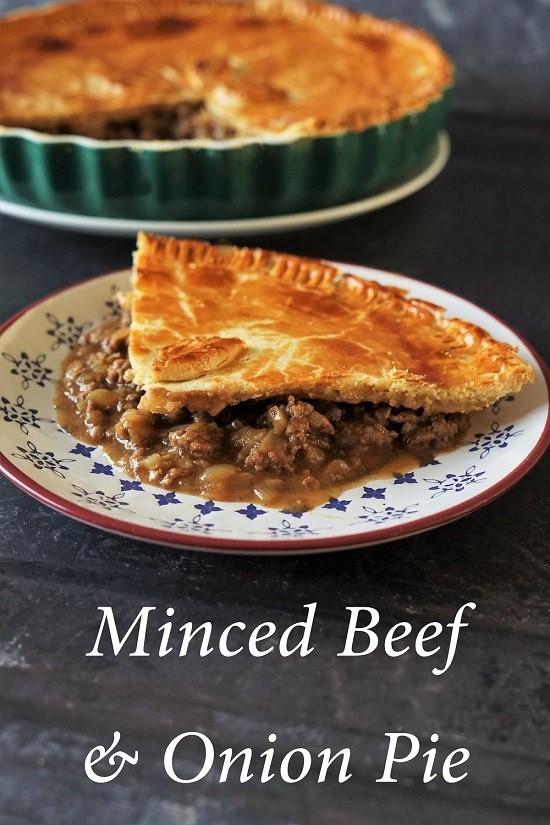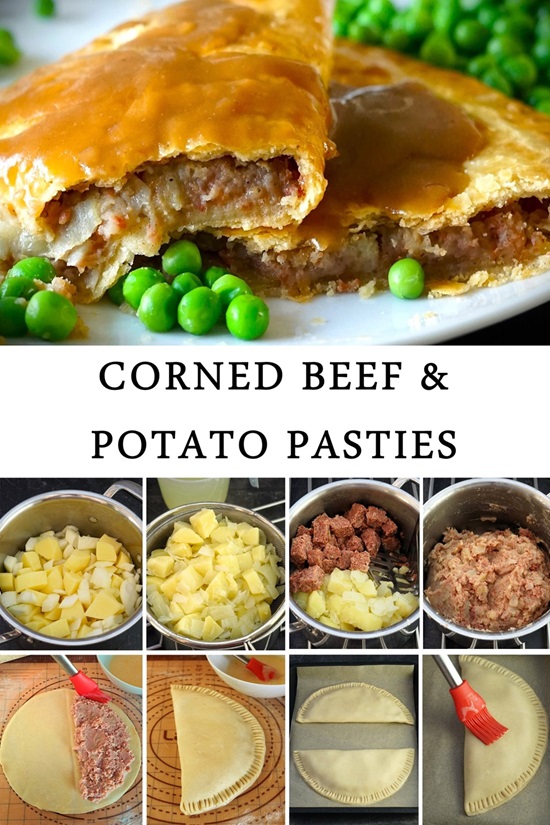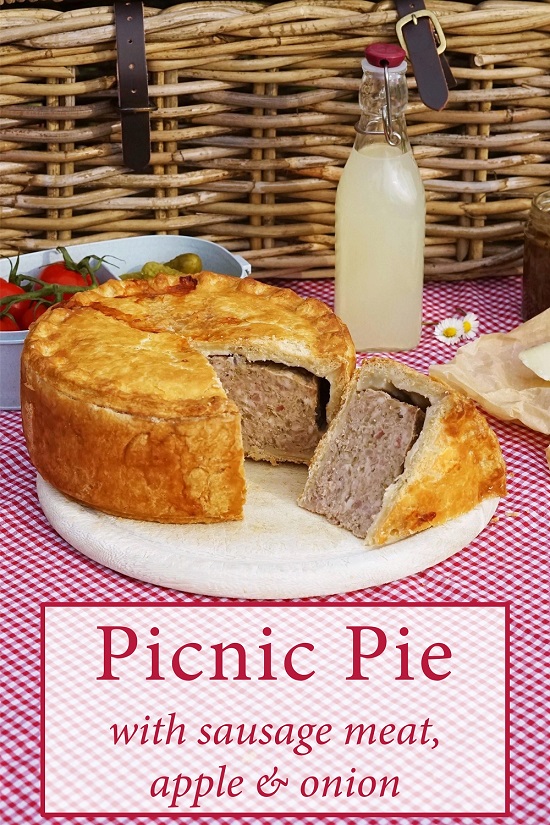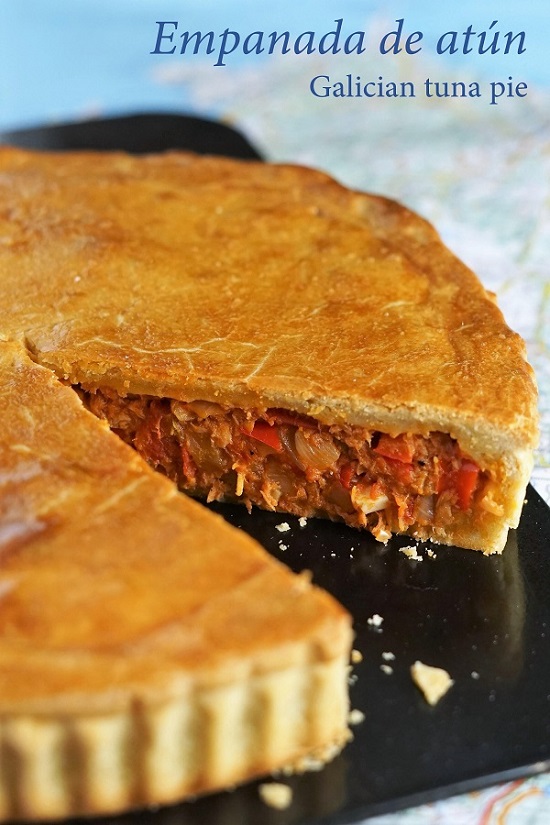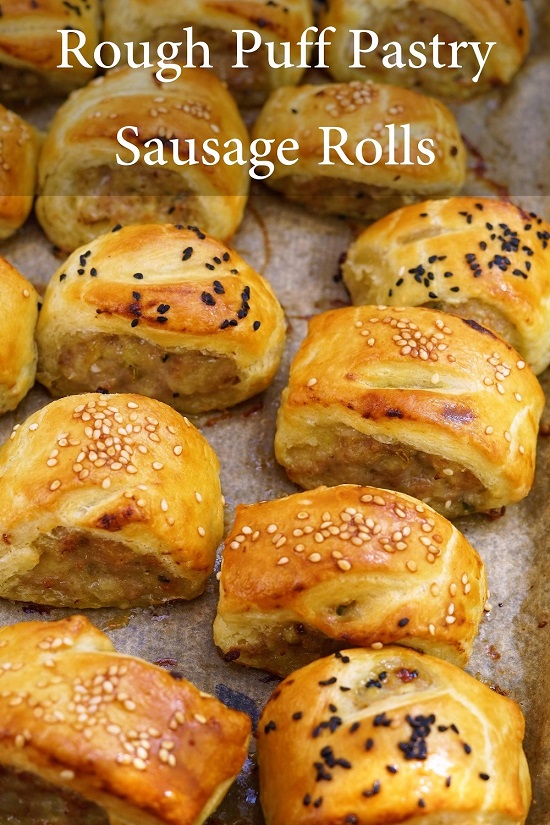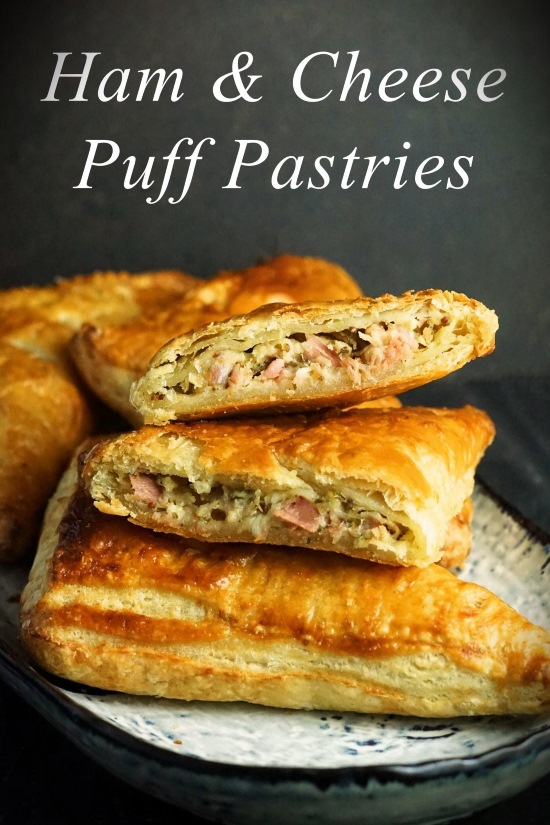Sausage Plate Pie
Sausage Plate Pie is easy, economical, and so tasty! With sausage meat and softened onions flavoured with a few dried seasonings baked in a simple shortcrust pastry, this homely pie makes a comforting, filling meal. Great served with mashed potatoes, vegetables and gravy, or chips and beans.
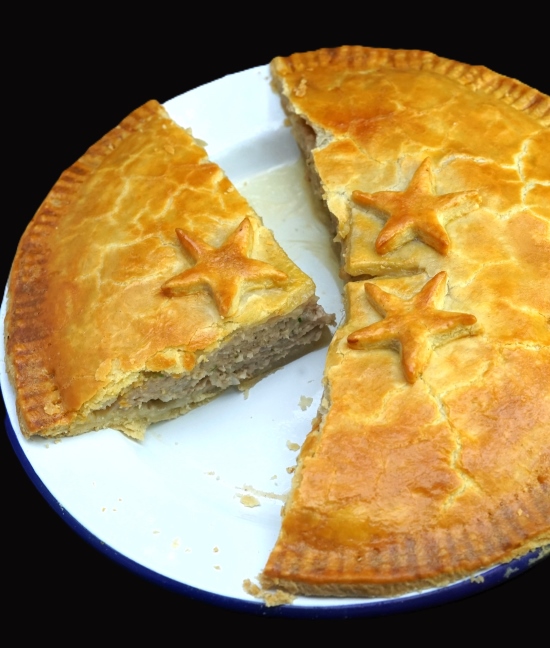
Disclosure: this post may contain affiliate links. If you buy via my links, I may earn a small commission at no extra cost to you.
Jump to Recipe
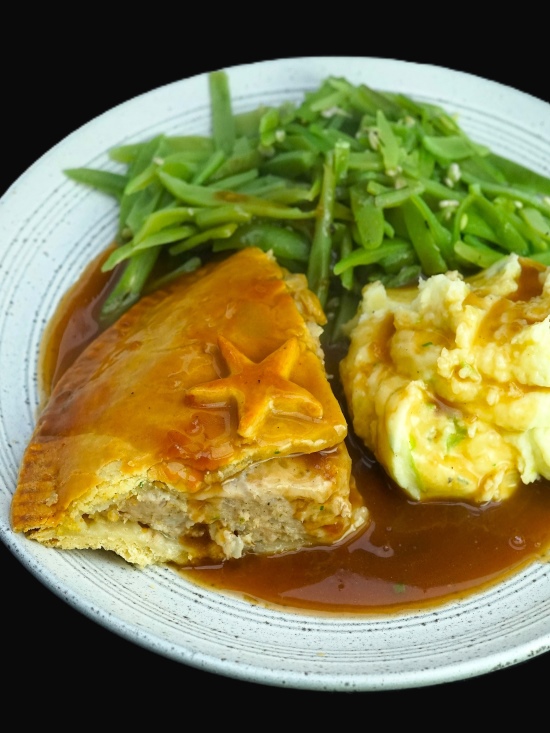
PLATE PIES: A BRITISH TRADITION
Plate pies seem to be particularly associated with Britain, especially the north and the Midlands. They’re double-crusted (i.e. have a pastry bottom as well as top) and are traditionally baked on enamel pie plates (affiliate link). The enamel is a good conductor of heat, helping to create a crisp base. Most familiar are the iconic white enamel plates with a dark blue rim, originally made in the 1920s in the Black Country near Birmingham.
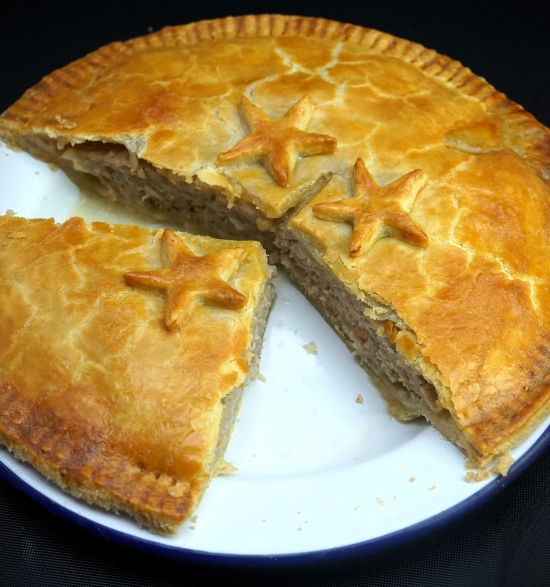
But any similar baking plate or shallow dish approximately 22 – 24 cm can be used, including another old favourite: the lid from a Pyrex casserole dish.
Plate pies can be a thrifty option as, being shallow, you don’t need as much filling as a deeper pie. The fillings themselves also tend towards the economical and homely. Well-loved favourites include cheese and onion, corned beef, or meat and potato where spuds stretch the meat further.
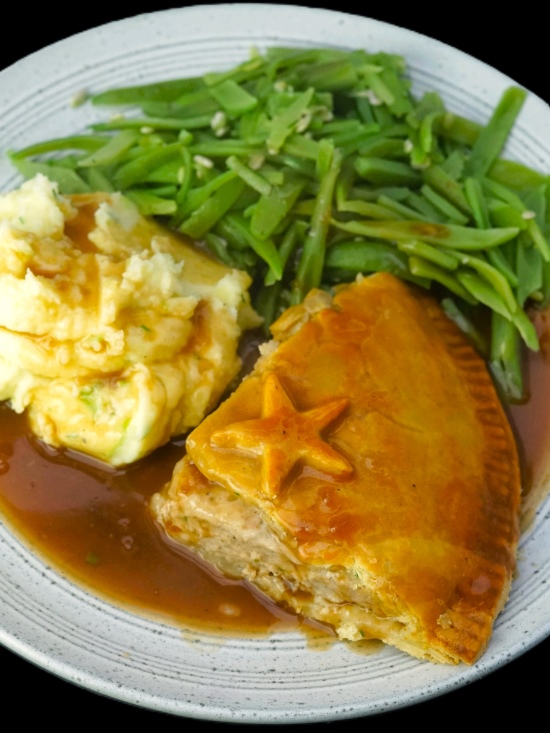
Sausages are another food associated with budget eating. But you might be surprised at just how good a Sausage Plate Pie can be.
SAUSAGE PLATE PIE
While Sausage Plate Pie is an economical dish, it isn’t worth using cheap sausage meat. Besides containing more fillers and additives, lots of fat will leak from a poor-quality product. And this will make your pastry soggy. Look for a meat content of at least 80 per cent. Ideally it should be 85 – 90 per cent, so go for the best quality you can.
For a Sausage Plate Pie to feed four to six people you’ll only need 400 grams of sausage meat so it’s still relatively inexpensive per portion.
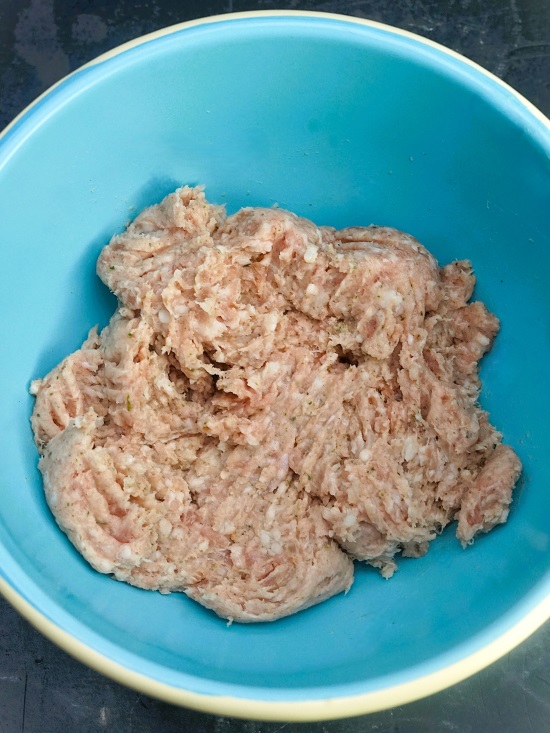
If you can’t find sausage meat, or sausage meat of good enough quality, then buy high meat content sausages and discard the skins.
The only other ingredients you need for the pie filling are onion, salt and pepper, plus your desired seasonings. I’ve gone for dried sage and thyme plus onion powder. But you could swap in mixed herbs, garlic powder, or whatever else you fancy. I like a shiny glaze so brush the pie with beaten egg. I also use some of the egg to seal the pastry lid. If preferred, you could use milk to glaze and seal, or omit the glaze altogether and just seal with water.
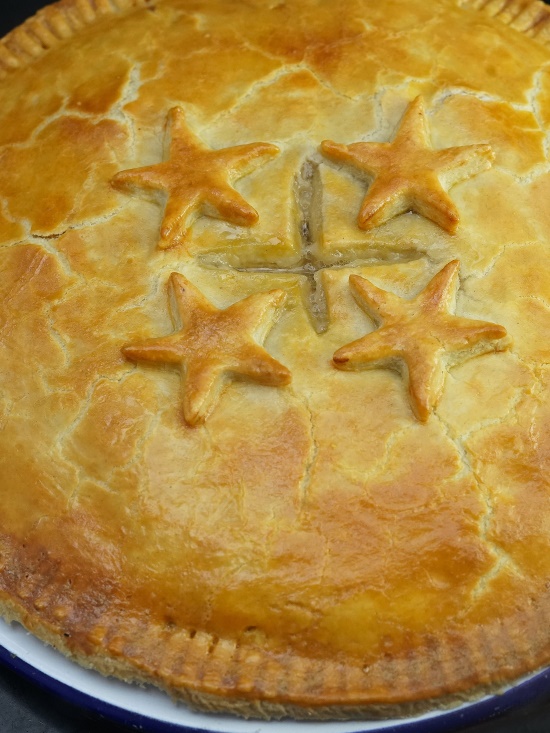
MAKE THE FILLING
To make the filling, start by chopping up a big onion and simmer it in water seasoned with salt and pepper. When it’s soft, drain and leave to cool. If you’re planning on making gravy to eat with your Sausage Plate Pie, drain over a jug and save the cooking water: it will make a very flavoursome base.
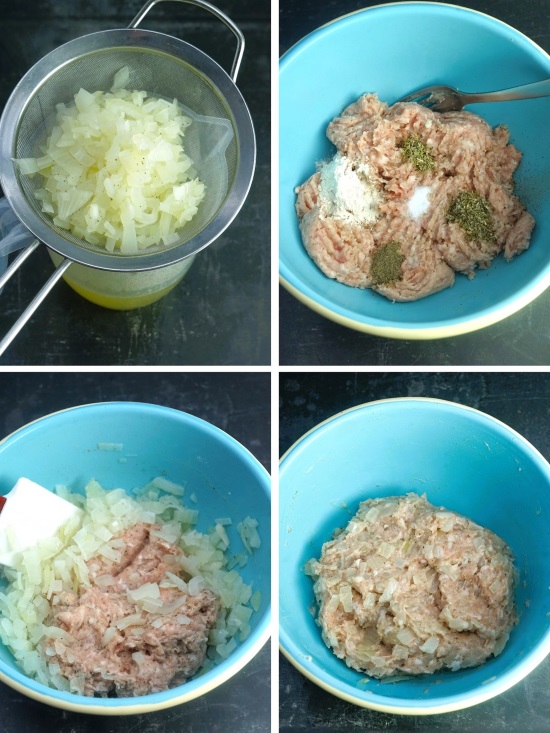
While the onion’s cooling, mix your chosen seasonings into the sausage meat. Then stir in the onion and combine everything well.
I highly recommend you then break off a marble-sized piece and fry it in a pan. Taste and adjust the seasoning of the rest of the sausage meat if you think it needs a little extra salt, pepper, or herbs. It would be such a shame to have an under-seasoned filling, so don’t skip this taste test.
EASY HOMEMADE SHORTCRUST PASTRY
While some plate pies are made with puff pastry, I think a simple shortcrust is much more appropriate given their humble origins.
Basic shortcrust pastry is quick and easy to achieve at home. And that’s true whether you make it by hand or whizz it up in a food processor. In the recipe card at the end, you’ll find instructions for both.
All you need are plain flour, salt, butter, and water. If you want to go properly traditional (and save money), you could replace half the butter with lard.
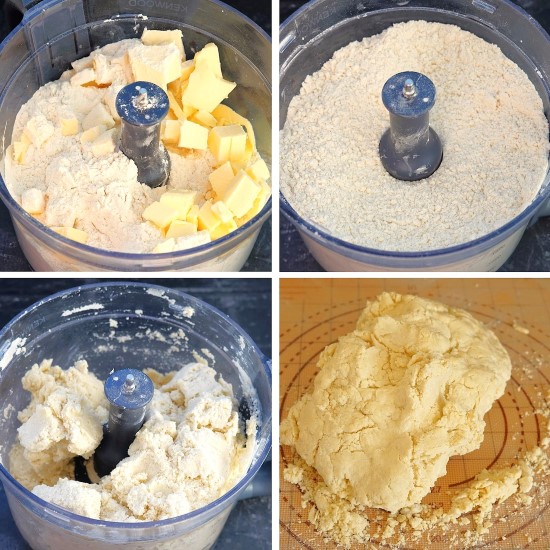
After you’ve made the pastry, it will need chilling in the fridge so rolling out is easier. This means it’s best to prepare it first, before the filling. Thirty minutes in the fridge, wrapped in foil or cling film, is usually long enough. But the pastry won’t come to any harm if it’s more convenient to make it further in advance.
Before chilling, I divide the pastry into two pieces: a larger one for the pie base and a smaller one for the lid. I always use scales and divide it roughly 60:40. For example, my pastry weighed 420 grams in total, so I set aside 250 grams for the base and 170 grams for the lid.
Flatten each piece into a disc then wrap in foil or cling film and put in the fridge.
ASSEMBLING SAUSAGE PLATE PIE
When you’re ready to assemble the pie, lightly dust your work surface, ideally covered with a silicone mat (affiliate link) to prevent sticking, and roll out the larger piece of pastry into a circle that will come just over the edge of your pie plate. Remember to take account of the dip in the middle of the plate if it has one. Place the pastry on the pie plate and gently press down, making sure it goes down into the dip. Holding up the plate in one hand, go around the edge with a knife to trim away any excess.
Now roll out the smaller piece of pastry a little bigger than your pie plate and set aside. If you have time, it’s always a good idea to chill the cut-out pastry again. This will help prevent any shrinkage during cooking. But if your pastry is still cool from its first chilling then it may not be necessary.
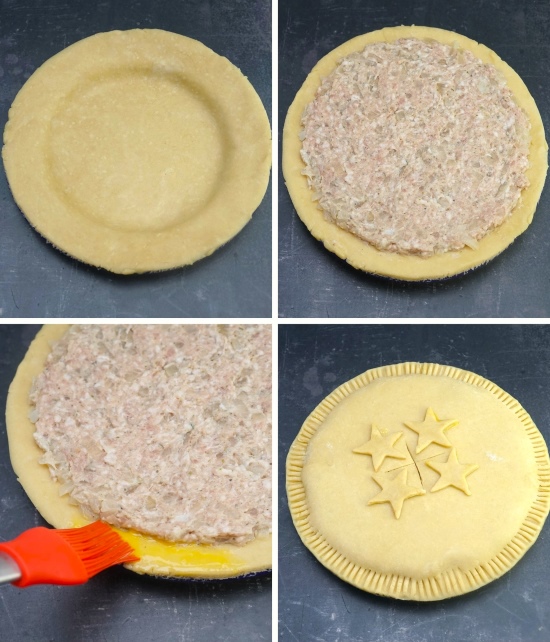
Now spread the sausage meat evenly all over the pastry bottom but leave a bare border of approximately 2 cm all around. Brush some of the beaten egg (or milk or water) all over the border. Place the pastry lid on top, pressing all around to seal. You can then cut off any excess pastry and go round again pressing down with the tines of a fork. Or pinch between thumb and index finger if you prefer to a wavy edge.
Instead of wasting any scraps of pastry, I gather and re-roll them to decorate the top, sticking them on using more of the beaten egg.
If you don’t want to cook the pie yet, you can chill it in the fridge.
BAKING SAUSAGE PLATE PIE
When you’re ready to bake the Sausage Plate Pie, brush a layer of beaten egg (or milk) all over the top. Then cut a cross, slits, or make holes in the centre: this is to let out steam as it cooks.
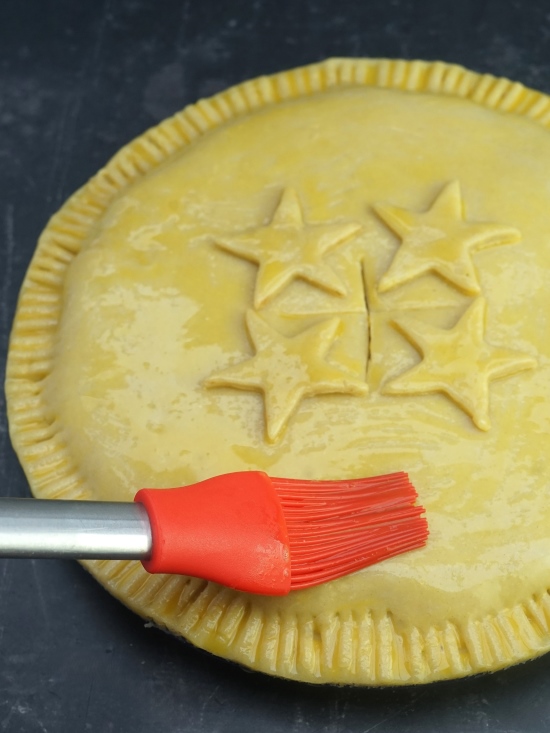
Your oven should be preheated to the temperature shown in the recipe card. Have a shelf in the middle position and put a large baking tray on it to preheat too. As well as helping to crisp the bottom of the pie, this will save any escaping fat or juices leaking into your oven.
To make sure that the pastry sets and the raw sausage is properly cooked, you’ll start the pie at a higher temperature then reduce it after 20 minutes. At the 20-minute mark I also take the opportunity to add another layer of beaten egg for a deeper glaze.
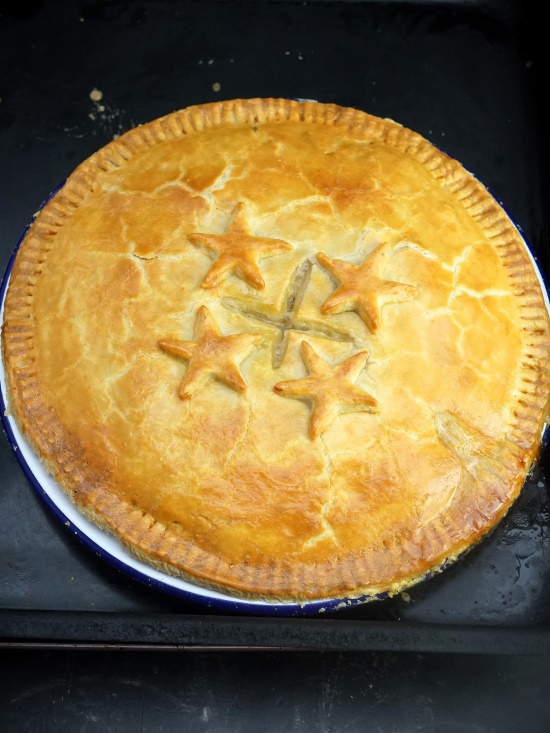
Back in the oven at the lower temperature shown in the recipe card, the pie should take approximately 30 minutes to get golden and cooked through.
As with most pies, it’s best to leave for 5 – 10 minutes before slicing. This gives the pastry a chance to firm a little.
SERVING SAUSAGE PLATE PIE
My favourite way to eat homely but so tasty Sausage Plate Pie is with gravy, mashed potato and boiled or steamed veg. That’s my idea of comfort food! For the meal you see in this post, the base of the gravy was saved bacon fat, flour, and a stock made with the onion cooking liquor. I flavoured buttery mash with spring onion steeped in a little warm milk which also went into the potatoes. The runner beans were homegrown.
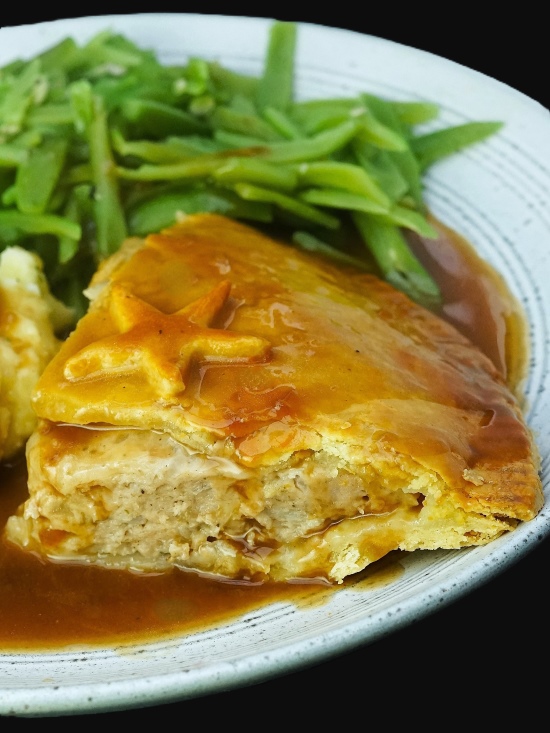
Classic pie accompaniments of chips and/or baked beans also go well with sausage pie. Either gravy or beans plus my Homemade Oven Chips are lovely with it.
Even made with quality sausage meat, this pie is still a good value, filling meal. And although the flavourings of onion and store cupboard herbs are incredibly simple, Sausage Plate Pie is sure to become a tasty favourite.
Have you made this recipe? Leave a comment and rating to let me know what you thought.
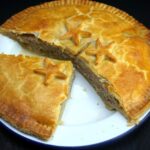
Sausage Plate Pie
A tasty pie of sausage meat, onions, and a few simple seasonings baked in homemade shortcrust pastry that's both easy and economical. Lovely served with mashed potatoes, veg and gravy, or chips and beans.
For best results use sausage meat with a meat content of at least 80 per cent to avoid too much fat soaking into the bottom layer of pastry. The seasonings listed are just a suggestion so swap in your own favourites e.g. mixed herbs, garlic powder.
You will need an oven safe round pie plate approximately 22 - 23 cm in diameter.
It's recommended that you read the accompanying blog post before starting the recipe.
Ingredients
For the shortcrust pastry
- 250 g plain flour
- 1 large pinch salt
- 125 g cold butter, diced (up to half can be replaced with lard)
- 3 - 4 tbsp iced water
For the filling
- 1 large onion (roughly chopped)
- salt and pepper (to taste)
- 400 g quality sausage meat (or sausages with skins discarded)
- 1 tsp dried sage
- 1 tsp dried thyme
- 1 tsp onion powder
For sealing and glazing
- 1 small egg, beaten (can be replaced with milk)
Instructions
Make the shortcrust pastry
-
If using a food processor
Put the flour, salt and butter into the food processor and whizz until the mixture looks like fine breadcrumbs.
With the motor still running add cold water, 1 tbsp at a time, until the mixture starts coming together.
If making by hand
Stir the flour and salt together in a bowl. Rub in the butter until the mixture resembles fine breadcrumbs.
Add 1 tbsp of cold water and stir it in with a round bladed knife. Continue adding tablespoons of water and stirring until the mixture starts coming together.
-
Turn out onto a lightly floured surface and gently knead into a smooth ball.
Weigh and divide in two: you'll need roughly 60 per cent of the pastry for the base and 40 percent for the lid. For example, if the dough weighs 420g then use 250g for the base and 170g for the lid.
Flatten each piece into a disc then wrap in foil or cling film and chill in the fridge for at least 30 minutes.
Make the filling
-
Put the chopped onion in a saucepan and add enough boiling water from a kettle to more than cover. Season with a little salt and pepper.
Bring up to a boil then turn down the heat and simmer until the onion is soft.
Drain the onion in a sieve over a jug to catch the cooking liquor: it makes a great base for gravy to serve with the pie.
Leave to cool a little.
-
Put the sausage meat in a bowl and break up with a fork. Add the sage, thyme, onion powder, ¼ tsp of black pepper or you own preferred seasonings.
Add the drained, cooled onion and stir everything together well.
Highly recommended: break off a small piece of the flavoured sausage meat and cook in a frying pan. Taste and adjust the herbs and seasoning if necessary, adding a little salt if you think it needs it.
Assemble the pie
-
On a lightly floured surface, roll out the larger piece of pastry into a circle that will come over the edge of your pie plate: remember to take account of the dip in the middle of the plate if it has one.
Place the pastry on the pie plate and gently press down, making sure it goes down into any dip in the middle of the plate.
Holding up the plate in one hand, go around the edge with a knife to trim away any excess.
Roll out the smaller piece of pastry a little bigger than your pie plate and set aside.
Tip: if you have time, it's a good idea to chill the cut-out pastry again. This will help prevent any shrinkage during cooking.
-
Spread the sausage meat filling evenly all over the pastry bottom, leaving a bare 2 cm border all round.
-
Brush beaten egg all over the bare border then place the pie lid on top, pressing all around to seal.
Cut off any excess pastry, then go round again pressing down with the tines of a fork or pinch between thumb and index finger for a wavy edge.
-
If liked, gather and re-roll any leftover scraps of pastry to make decorations for the pie. Stick them on using some of the beaten egg.
Tip: the pie can be chilled in the fridge at this stage and cooked later if liked.
Bake the pie
-
Preheat your oven to 200°C / 180°Fan /Gas 6 /400°F with a shelf in the middle and a large baking tray on it (preheating a tray helps to crisp the bottom of the pie and will also save any fat or juices leaking into your oven).
-
Brush a layer of beaten egg all over the pie.
Cut a cross, slits, or make holes in the centre to let out steam.
-
Transfer the pie to the tray in the oven and bake for 20 minutes.
After 20 minutes, reduce the oven temperature to 180°C / 160° Fan /Gas 4 / 350F.
Optional: Take the pie out of the oven and add another layer of beaten egg and return to the oven.
Bake until golden and cooked through: approximately 30 minutes more.
-
Rest the pie for 5 - 10 minutes before slicing and serving.
-
Cooked pie will keep in the fridge for 2 - 3 days or can be frozen.
Reheat thoroughly in a moderate oven, microwave or air fryer (you can quickly reheat in a microwave then transfer to the oven or air fryer to re-crisp the pastry).
RELATED RECIPES

